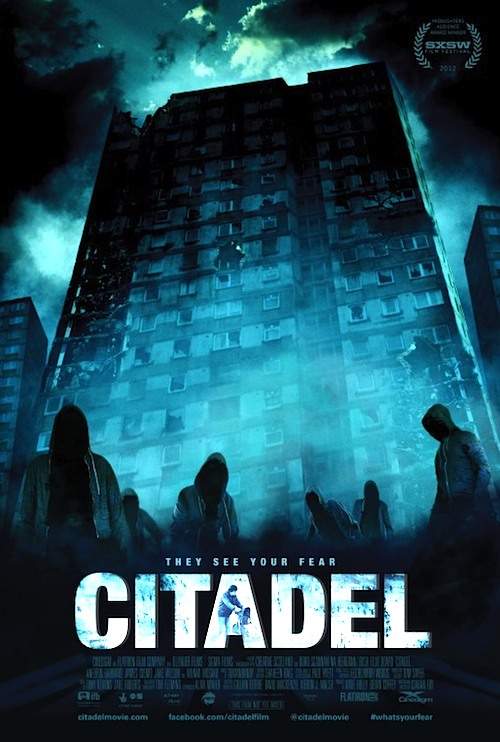By Joe Bendel. They are not merely the misunderstood and marginalized. The hellions inhabiting a shunned Irish housing project thrive on fear. In fact, they can literally see it. Whether they are truly supernatural creatures or not is left rather ambiguous, but their feral savagery is beyond doubt throughout writer-director Ciarán Foy’s Citadel, which opens this Friday in New York.
Tommy Cowley and his pregnant wife were the last decent people to move out of their ominous looking housing project. Unfortunately, they waited too long. While trapped in the typically malfunctioning elevator, Cowley witnesses the fatal assault on his wife. However, their infant daughter Elsa survives. The incident deeply scars Cowley. An agoraphobic basket case, he becomes convinced that the hoodie shrouded thugs are after Elsa. He might be a nervous wreck, but he is not paranoid.
 During several harrowing nighttime home invasions, Cowley barricades himself and Elsa in the bathroom as the hooded hooligans rampage through their flat. Cowley finds a sympathetic ear and temporary shelter with Marie, a kindly nurse. She insists that the delinquents living in the title high rise are just disadvantaged youths, who lash out to vent their frustration with the system. Unfortunately, she will be proved dead wrong. However, the misanthropic parish priest understands what they are only too well.
During several harrowing nighttime home invasions, Cowley barricades himself and Elsa in the bathroom as the hooded hooligans rampage through their flat. Cowley finds a sympathetic ear and temporary shelter with Marie, a kindly nurse. She insists that the delinquents living in the title high rise are just disadvantaged youths, who lash out to vent their frustration with the system. Unfortunately, she will be proved dead wrong. However, the misanthropic parish priest understands what they are only too well.
Aneurin Barnard is almost too convincing as Cowley. Every twitch of his body language screams victim. To see him is to want to mug him. He is so put-upon, viewers almost, but don’t quite lose patience with him. Conversely, James Cosmo tears into the scenery and everything not nailed down with rip-roaring relish as the caustic priest.
While Foy eventually drops some pretty clear hints regarding the nature of the Citadel dwellers, it hardly matters. They are simply mindless tormentors. As anyone who has watched Room 237 (the cinematic deconstruction of Kubrick’s The Shining) understands, authorial intent is irrelevant to critical theory. With that in mind, Citadel can clearly be interpreted as an allegory for the War on Terror, regardless of Foy’s conscious intent. Clearly.
So let’s have a little fun with this, shall we? Like al-Qaeda and their ilk, the hooded ones spread terror for its own sake. There is no reasoning with them. The West can lock itself in the bathroom and hope they go away, but that strategy is obviously doomed to failure over time. Marie is attractive and conciliatory, like a classic appeaser, but her course only leads to death. So to protect the future of liberal democracy for Elsa and the rest of our children, we need to follow the advice of the priest – call him the Dick Cheney figure – and hook up the plastic explosives to the car battery.
Right … or possibly not. Who’s to say? The point is that Citadel taps into some profound fears, burrowing under the skin like a bionic tick. It has to be the grittiest, grimiest, grimmest horror film you are likely to see in a good long time. Cinematographer Tim Fleming’s oppressively grey look sets the mood of foreboding right from the start, while Foy steadily builds the tension as he repeatedly cranks Cowley through the wringer. Despite the absence of a strong focal villain, it is a chillingly effective horror film. Highly recommended for genre fans, Citadel opens this Friday (11/9) in New York at the Angelika Film Center.
LFM GRADE: B+
Posted on November 6th, 2012 at 9:39am.